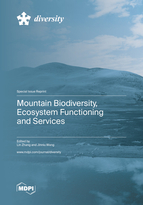Detection and Quantification of Forest-Agriculture Ecotones Caused by Returning Farmland to Forest Program Using Unmanned Aircraft Imagery
Round 1
Reviewer 1 Report
The manuscript is well written and presented. There are a few suggestions for improvement:
1. Improve the English Language throughout the manuscript.
2. Methodology flowchart missing, include for greater visibility and readability
3. Improve resolutions of all figures, with scale, legend, and attributes all uniform.
4. Add discussion with validations
5. Conclusion must be rewritten as per the topic and methodology
Author Response
Please see the attachment.
Author Response File: ![]() Author Response.pdf
Author Response.pdf
Reviewer 2 Report
This is a valuable study improving monitoring methods using unmanned aircraft imagery. The new method provides very high resolution remotely sensed data about large region and offers new perspectives in collecting comprehensive environmental data for sustainable planning and management. Overall the study is well presented with good logic and structure. The text written in good English and it is easy to follow. Illustrations (including supplementary material) are clear and well elaborated. However, some details should be improved. Methods section about field data collection needs better explanation and I also found parts in analyses that need clarifications.
The authors are using very many abbreviations (CHM, DSM, GCP, GLCM, RGB, RTK, UAS, UAV etc…) that is challenging for readers. I strongly suggest to prepare an ABBREVIATIONS sections after the KEYWORDS to help general readers who are not experienced in this terminology. In addition, please check that all terms (with abbreviations) should be defined and explained in main text when it has appeared first. In fact, I did not find such definitions in some cases: “RGB” (L20), “UAV” (L104), “GCP” (L145), “ESP” (L170).
Other comments
L96-L97 “However, data with varying resolutions may result in estimating errors.” Not clear, please, explain context and give reasoning.
L 113 Site description. Please, give information about meteorological condition, natural vegetation and soil in the area. Please, give the dates when agricultural activity was abandoned in the particular research site. Give also information about the size of the area, the temporal length, i.e. how long the area was used for agriculture and what crops were cultivated. You mentioned grazing and firewood collection as typical disturbances in the area. Are these disturbances important drivers in the development of ecotone patterns?
L 126-150 In-situ data. Please, give details about soil sampling (year, season, sample size, depth, spatial arrangement of soil sampling units (L 135-137). How the plot sizes (5x5m and 10x10m) were selected? The sentence “… work of plant species investigation” (L 134) is implicit. Give details about vegetation sampling. Were UAS imageries taken in the same year and season as field data collection?
Figure 2. is nice. However, caption needs improvement. What blue- and white-colour boxes means? Explain here abbreviations as well making the figure understandable if it stands alone.
The sentence “…and the changes in a land scape may reflect the extent of disturbance” (L 284-285) is not clear. Please, explain what kind of disturbance and how it shapes the ecotone.
L 299 sampling and calculation of IV is not clear. IV would be better to call as “importance value” and not as “important value”. Considering the high resolution 3D patterns created from images by your methodology it is not clear why IV, pH and OM were used as field attributes for characterizing ecotone? It would be more operational using plant height (canopy height) data measured in field survey for validation with field data.
L 305 what is “sub-window”? 5 x 2.5 m (half of 5x5m)?
L 310 - L 313 not clear. Please, reword.
L 319 why normalization is necessary? What is “mean” here? How “mean” attributes (L 322) were calculated (how many plots).
L 347-356 This paragraph is not clear. What are TP, FP and FN and how they are calculated? (I could not understand from this text.)
Fig.4. give units to scales.
L 386-387 The following sentence: “This landscape pattern indicates the gradient of vegetation restoration between abandoned farm land and forest” can be misleading. By “restoration” we used to call active planting or seeding. In case of spontaneous processes it is better using other terms e.g. “spontaneous regeneration” or “spontaneous recovery”.
Table 3. Use consistent terms. Ecotone width or ecotone length?
Table 3. The following sentence: “For the meaning of TP, FN, and FP, refer to the accuracy assessment section above” is not clear (the explanation in L 347- L 356 were also unclear).
Fig. 6. Please give scales to colours for each transects. It would be useful marking explicitly the position of ecotones (start-end).
Discussion
Most part is clearly written.
L 445-446 “In the natural state of abandonment, the area of the grassland (i.e., the abandoned farmland) would diminish” unclear. I suggest to delete this sentence (or give a longer more detailed explanation).
L 497-500; L 509-528; L 524-525; L 565-568 Excellent reasoning.
Supplements (it is clear and useful but some small points need clarifications)
Figure S1 use „G” for small plots. However, Table S1 use „A” please, harmonize notation.
Table S1 caption „important value” should be „importance value”
Table S1 caption „pondus dydrogeni” should be „pondus Hydrogenii”
Table S1 meaning of „IV” is not clear (total plant cover?) Why canopy height was not measured?
Author Response
Please see the attachment.
Author Response File: ![]() Author Response.pdf
Author Response.pdf
Reviewer 3 Report
The research is clearly explained and the paper is well structured. This paper has a good quality and can be considered for publication, even if the interest for readers is limited, since it cannot be considered innovative or useful in providing data for forest planning or for biodiversity conservation. Some minor observations:
117+120-121 Scientific species names (Pinus yunnanensis, Chamaenerion nepalensis and Desmodium yunnanense) should be written in italics.
139-140. Missing information
Author Response
Please see the attachment.
Author Response File: ![]() Author Response.pdf
Author Response.pdf






